Korean marinated raw shrimp or ‘saewoo jang‘ (새우장) is the epitome of authentic Korean cuisine. It’s made with raw succulent shrimp that has been cured in a delicious umami-packed soy marinade. It’s similar to soy raw marinated crab or ‘gangjang gejang‘ and Korean marinated salmon sashimi or ‘yeoneo jang‘ in that it’s soaked in a soy-based marinated. However, the difference lies in the flavor and texture of the shrimp.
Texturally, raw shrimp has a fleshy and firm consistency. In terms of flavor, it’s subtly sweet with a hint of brininess. If you’ve ever had raw shrimp at a sushi restaurant or omakase, you’d know what flavor and texture profile I’m referring to.
In Korea, this dish is commonly known as ‘rice thief’ or ‘bap doduk’ [밥도둑] because it is so flavorful, that it’ll compel you to eat more rice than you normally do. Out of all the Korean raw marinated dishes, this is my hands down favorite. And I guarantee you’ll need extra rice for this one!
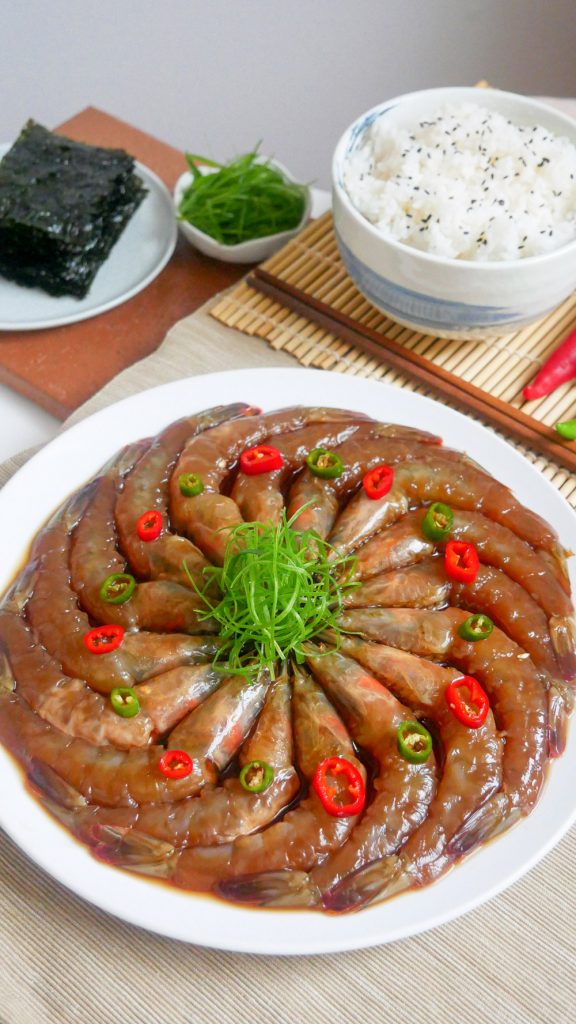
Why you’ll love this recipe
If you’re a seafood lover, this dish will absolutely blow your mind. The raw shrimp is soaked to perfection in a savory, aromatic, and slightly sweet marinade – just perfect with a bowl (or two) of rice. As you take a bite of the shrimp, you’re met with a soft yet firm texture which is followed by a burst of natural sweetness and brininess from the shrimp and richness and savoriness from the soy marinade.
Now, I’ll be honest with you – it does take a bit of prep work to clean and trim the shrimp. However, once the prep work is done, everything else is fairly easy and straightforward. I promise it’s well worth the effort and time because it’s irresistibly delicious. The best part is, you can make this up to 2 days in advance so it makes for a quick yet satisfying meal.
Depending on my mood, sometimes I’ll have this with perilla leaves, seaweed, or just plain rice!
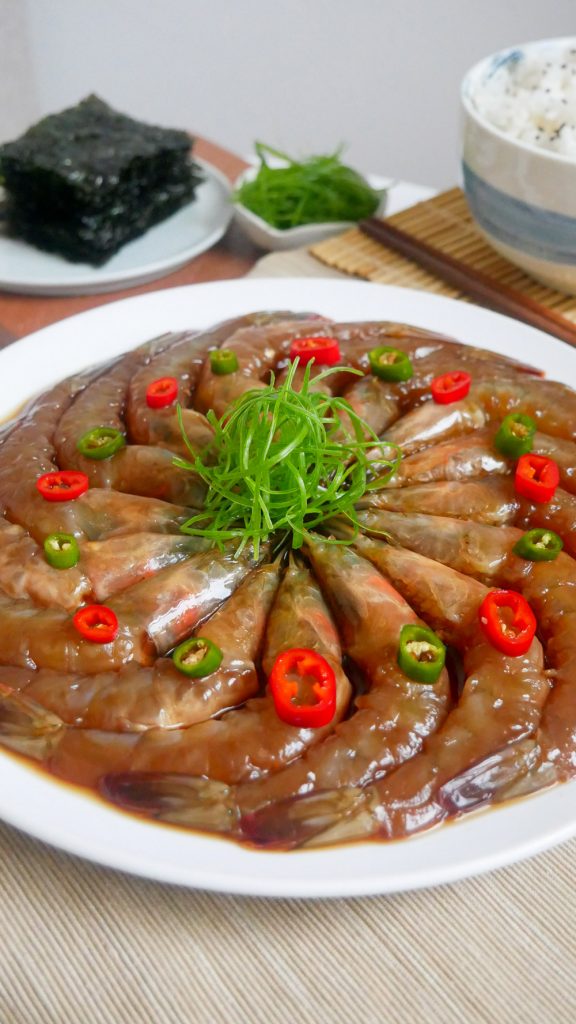
Marinated Raw Shrimp Ingredients & Substitutions
Frozen raw shrimp: It’s very important to use frozen shrimp for this recipe because the freezing process will kill any parasites. If you have a reliable source of fresh shrimp, that would be the only exception. Keep in mind that there are still risks in consuming raw shrimp, just like any other raw seafood. I used head-on white shrimp for this recipe but this is optional.
Soju: the soju is used to cleanse and remove any unpleasant seafood odors from the shrimp.
Onion: onions are used in two ways in this dish. The first way is used as a topping on the shrimp. It gets marinated with the shrimp, which adds flavor and draws out the onion’s natural sweetness.
Cheongyang pepper: cheongyang pepper is a type of Korean green pepper. It’s fairly spicy and can be substituted with serrano, jalapeno, or habanero peppers.
Red chili pepper: this pepper is primarily added for a contrast in color with the green peppers. It can also be substituted with serrano, jalapeno, or habanero peppers.
Lemon: the lemon slices add a subtle hint of acidity and tanginess to the marinade. It helps to cut through the savoriness and richness of the dish.
Marinade
Soy sauce: since this is a soy-based marinade you want to use a high-quality and robust soy sauce. I recommend using a Korean brand of soy sauce like Sempio.
Water: water is used to dilute the saltiness of the soy sauce. While the ratio of water and soy sauce is just right for me, you can adjust this based on your preferences. For example, if you prefer a marinade that isn’t as salty, you can add more water.
Soju: the soju adds a subtle sweetness and aroma that is comparable to vodka. The soju can be substituted with mirin or sake.
Mirin: the mirin adds a hint of sweetness to the marinade. It also helps to remove any unpleasant odors from the dish. Mirin can be substituted with soju, sake, or dry sherry.
Plum extract syrup: also called ‘maesil cheong’ (매실청), the plum extract is sweet and slightly tangy. It also helps to get rid of any unpleasant odors from the marinade. The plum extract can be found at your local Korean market or on Amazon. It can also be substituted with sugar.
Sugar: sugar is used in the marinade to balance out the saltiness in the dish.
Dried kelp: also known as ‘kombu’, the dried kelp adds a depth of umami flavors to the marinade. It can be purchased at your local Korean market or on Amazon.
Onion: this is the second way that onion is used in this dish. It helps to develop and deepen the flavors in the marinade.
Apple: the apple adds a touch of fruitiness and sweetness to the marinade. Korean pear would also be a good substitute.
Scallions: the scallion adds a subtle peppery flavor to the marinade, which can also be substituted with more onion. If substituting, add 1/4 more onion.
Garlic: the garlic adds a beautiful aroma and flavor to the marinade. Feel free to add more garlic, but not less!
Ginger: the ginger adds a touch of spiciness and helps cut through the richness. Only a small amount of ginger is needed!
Cheongyang pepper: cheongyang pepper is added to the marinade for a kick of spice. It can be substituted with serrano, jalapeno, or habanero peppers. If you prefer the marinade to be mild in spice, you can skip this.
Dried pepper: the dried chili pepper helps to deepen the flavors and add spice to the marinade. This can be substituted with Thai chili peppers, jalapeno, or serrano peppers.
Whole black peppercorns: the black peppercorns add a peppery and floral flavor to the marinade.

How to prepare Marinated Raw Shrimp
Step 1: Prepare the marinade
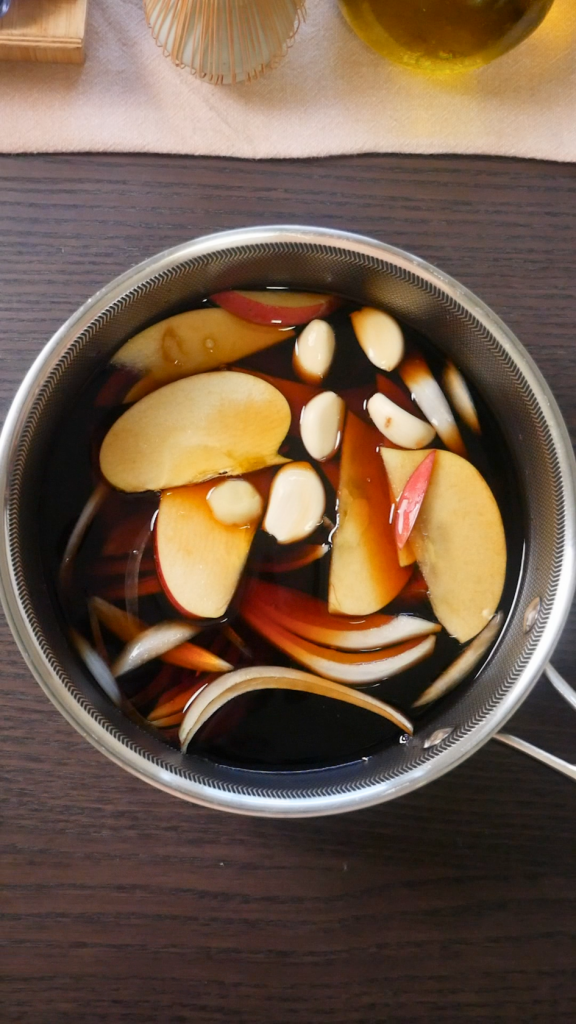
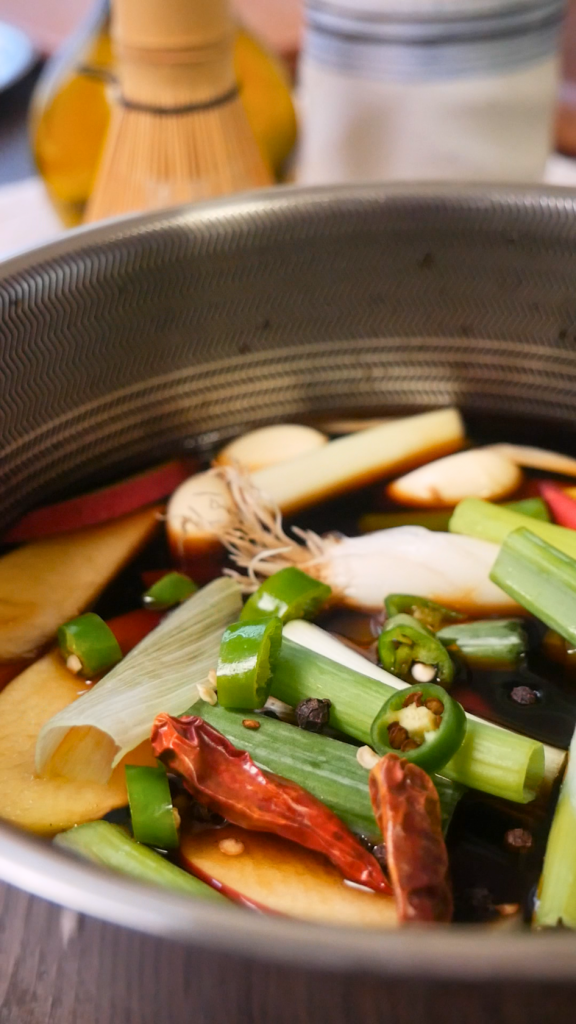
In a pot, combine soy sauce, water, soju, mirin, plum syrup, sugar, dried kelp, onion, apple, scallions, garlic, ginger, cheongyang pepper, dried pepper, and peppercorns.
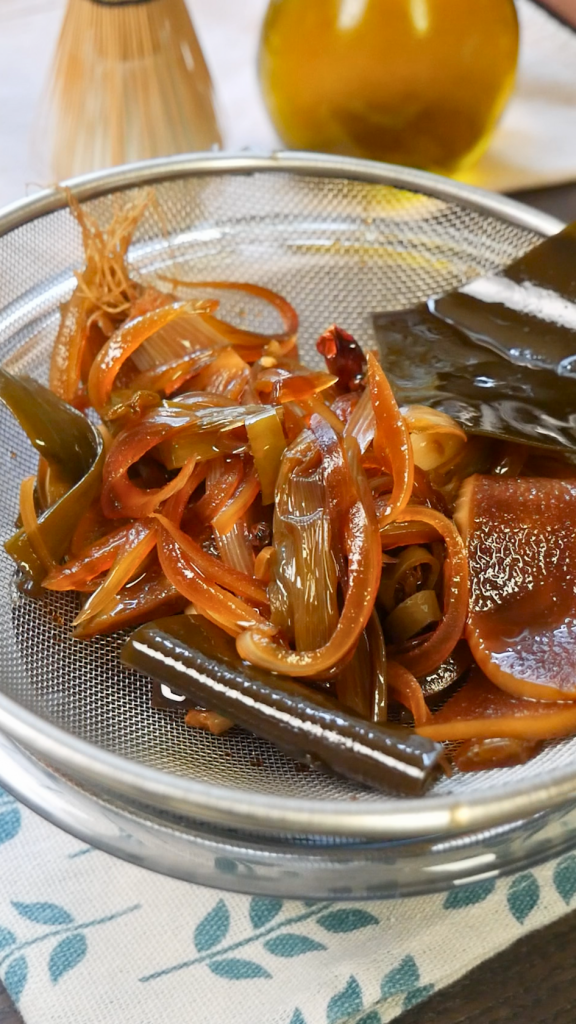
Bring to a boil over medium heat then reduce to a simmer. Simmer for 10 minutes then strain. Transfer to the fridge to cool completely.
Step 2: Prepare the shrimp
If shrimp is still frozen, soak it in a bowl with 4 cups of water and 1 tablespoon of salt for 30 minutes or until defrosted. If your shrimp is already defrosted and thawed, skip this.
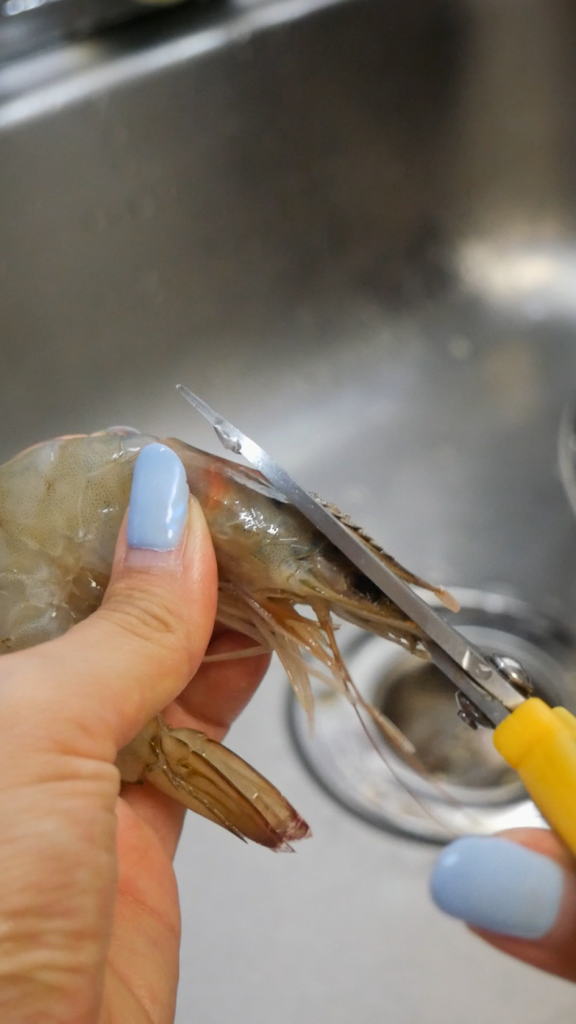
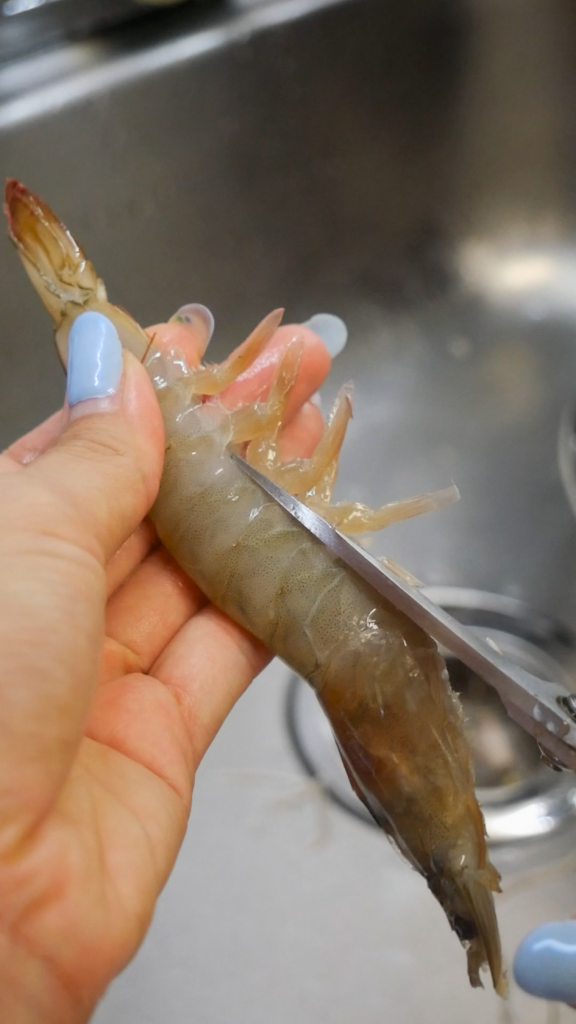
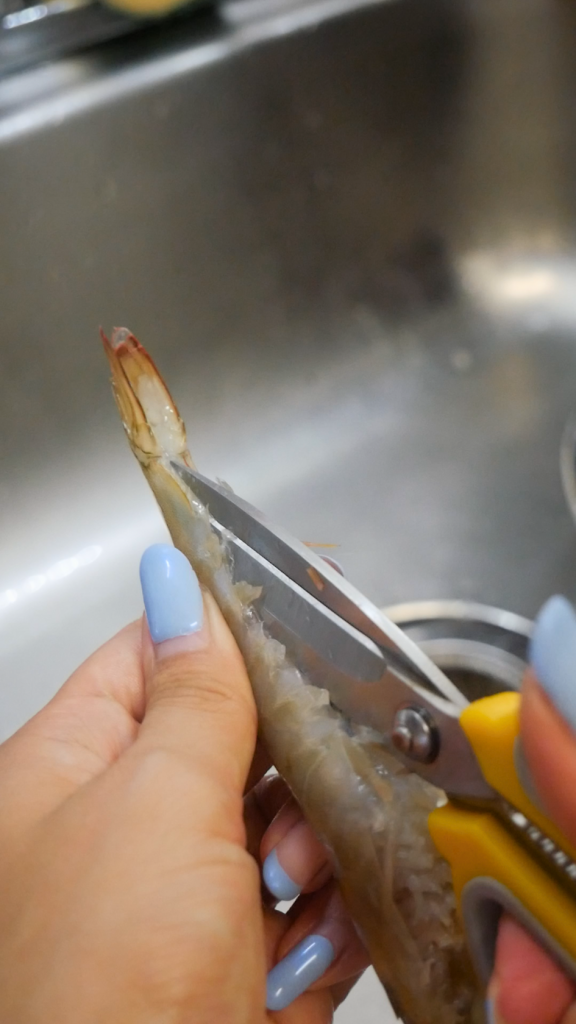
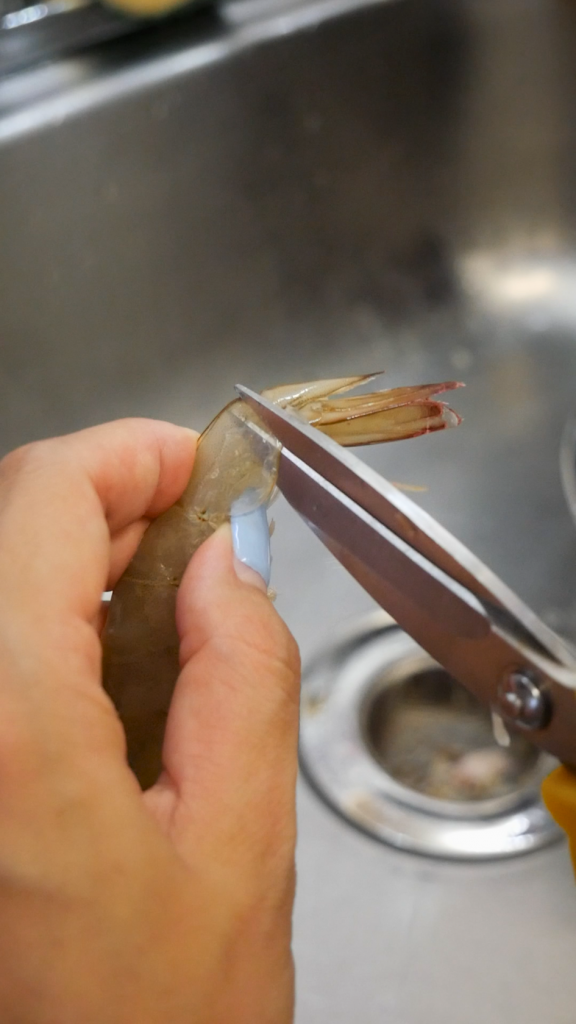
Using a pair of sheers, cut the pointy areas of the head, whiskers, and legs. Carefully remove the shell from the body of the shrimp. The tail can be left on or taken off – it’s your preference!
Step 3: Devein and clean the shrimp
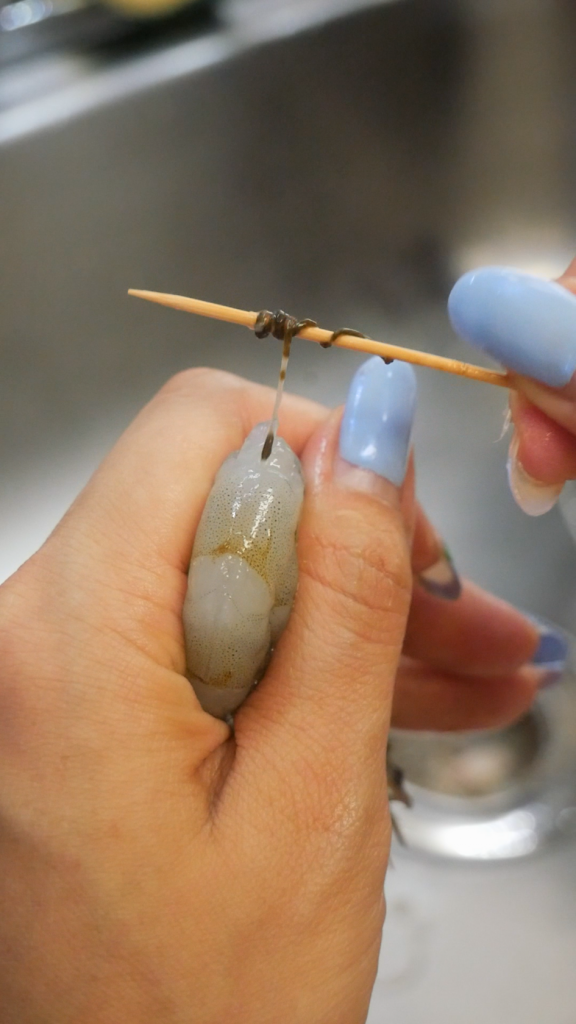
Next, devein the shrimp with the toothpick. Repeat until all shrimp is cleaned.
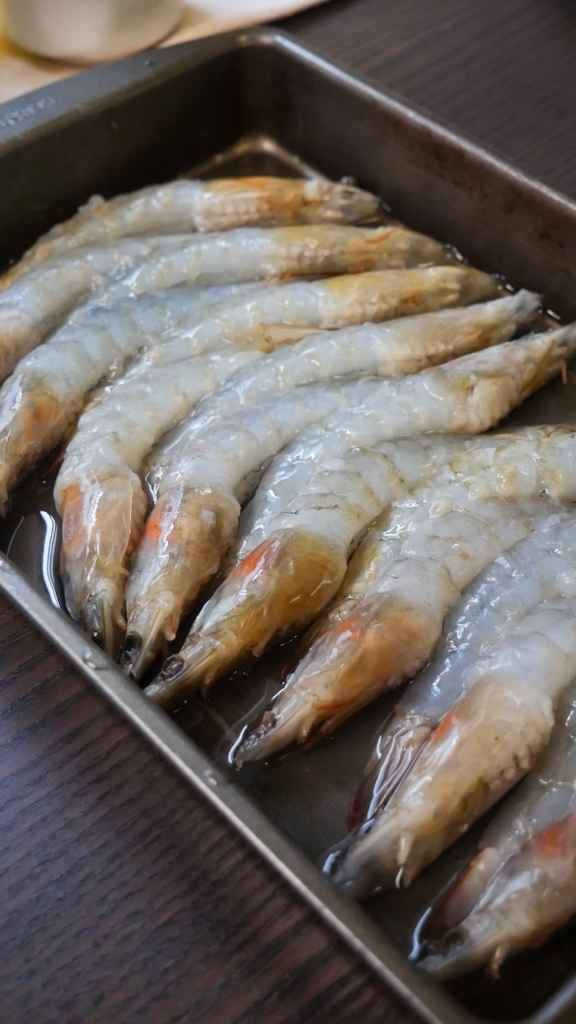
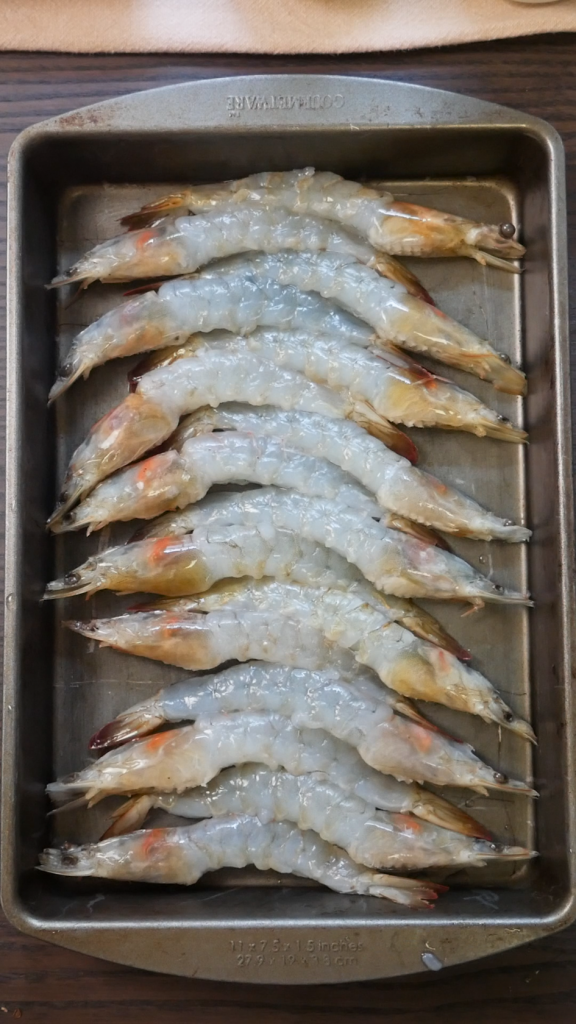
Transfer the shrimp to a shallow plate. Add 1/2 cup soju and soak for 10 to 15 minutes. Rinse under cold water then strain well.
Step 4: Assemble
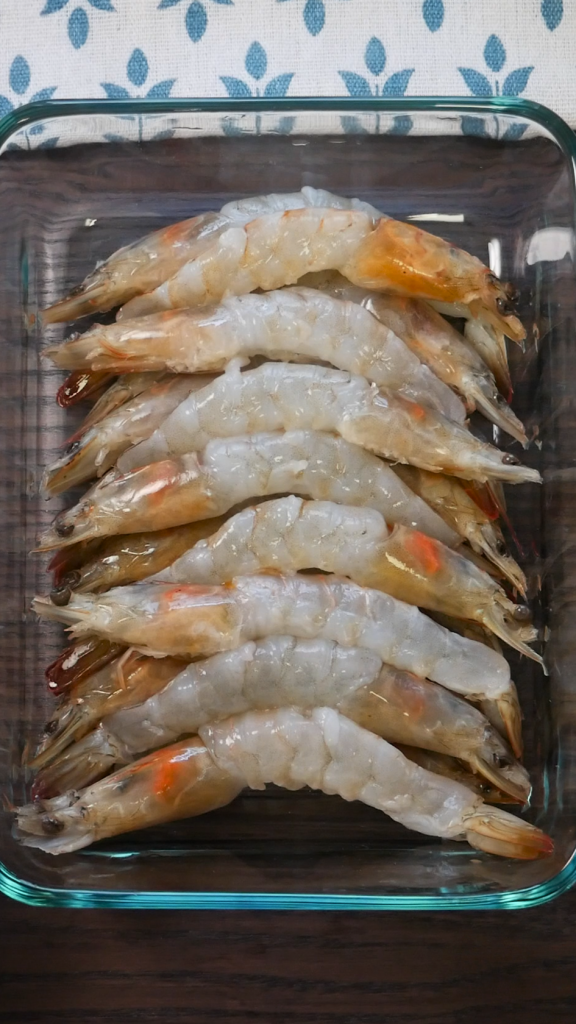
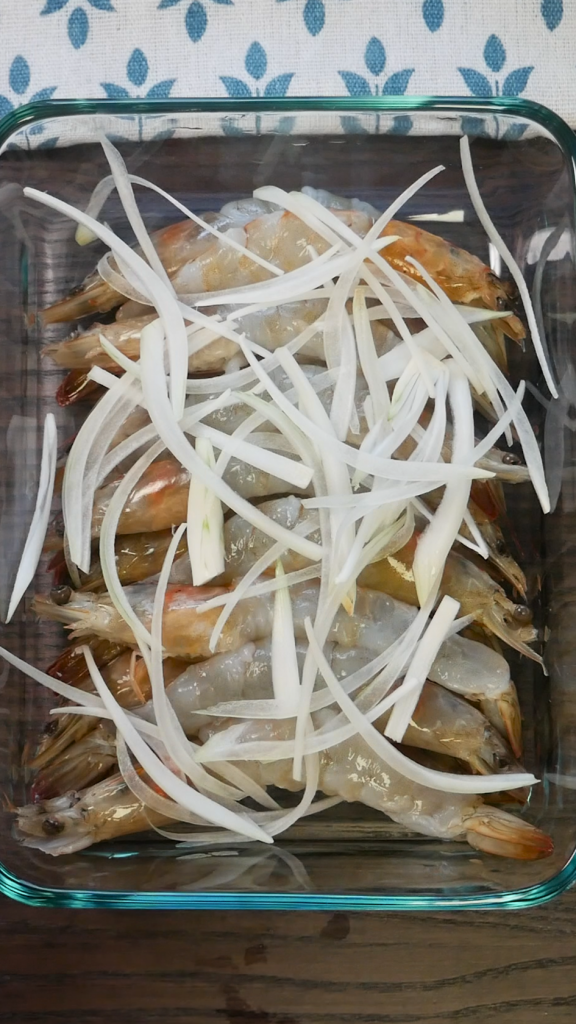

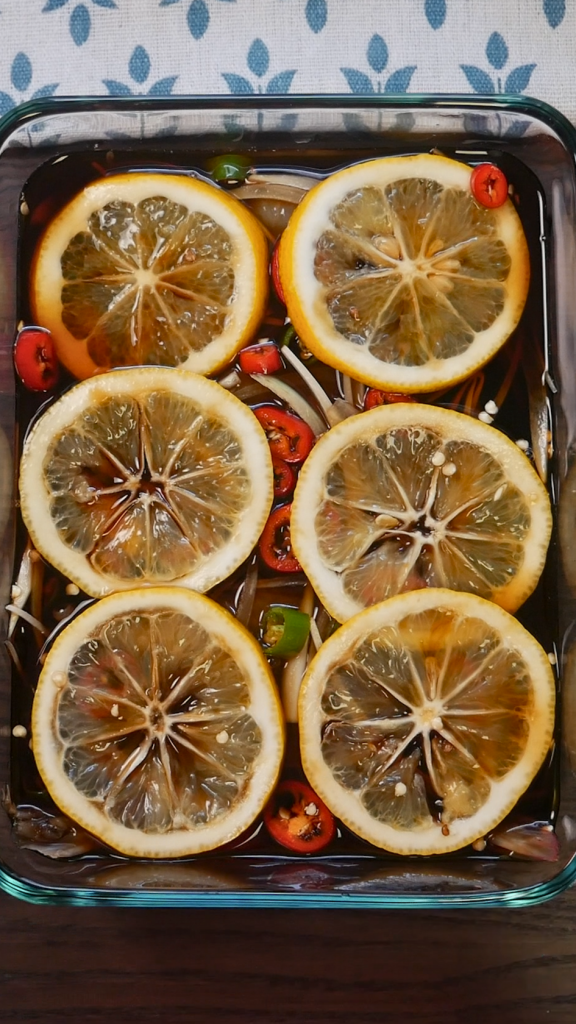
Transfer the shrimp to a clean glass container. Top with onions, cheongyang pepper, red pepper, and lemon slices. Pour the chilled marinade on top of the shrimp. Cover with an airtight lid then place in the fridge for at least 24 hours or up to 48 hours.
Step 5: Serve!
Serve with a bowl of rice and enjoy!
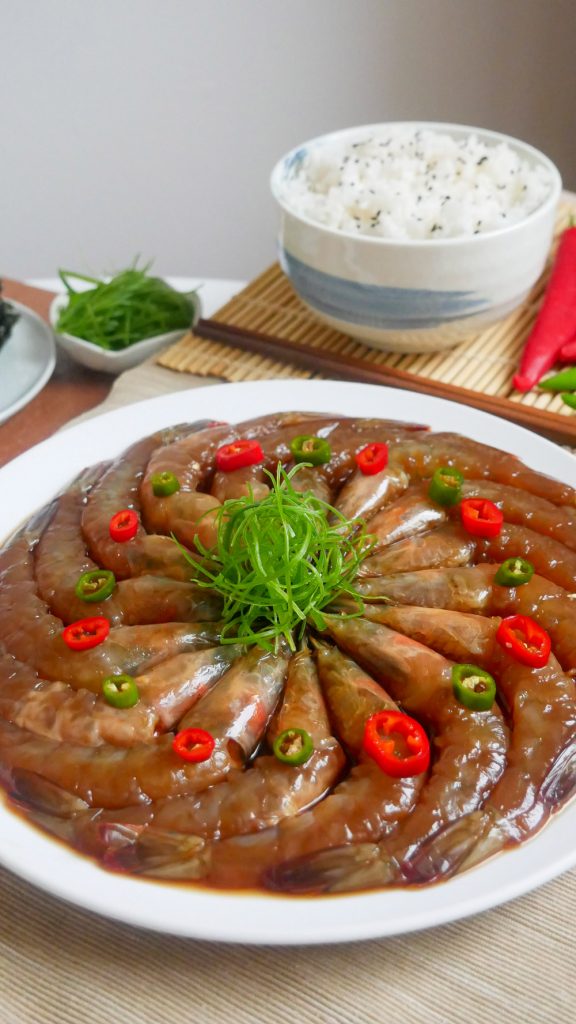
Preparation Tips for Marinated Raw Shrimp
- As mentioned above, it’s important to use frozen shrimp because the freezing process will kill any parasites. However, if you have a reliable source or vendor for fresh shrimp, that would be the only exception.
- If using shrimp that is still frozen, soak it in a bowl with 4 cups of water and 1 tablespoon of salt for 30 minutes or until defrosted. Alternatively, if you take the shrimp out of the freezer and transfer it to the fridge the day before to thaw, you can skip this.
- Do not skip the process of cleaning and deveining the shrimp! While this is meticulous and may require a little bit of time and effort, this will make the dish even more enjoyable.
- Keep in mind that the longer the shrimp marinates the more flavorful and salty it will be. For me, 24 hours is just right but it can be marinated for up to 48 hours.
- I like serving this dish with scallions, perilla leaves, or seaweed. Give one of those a try!
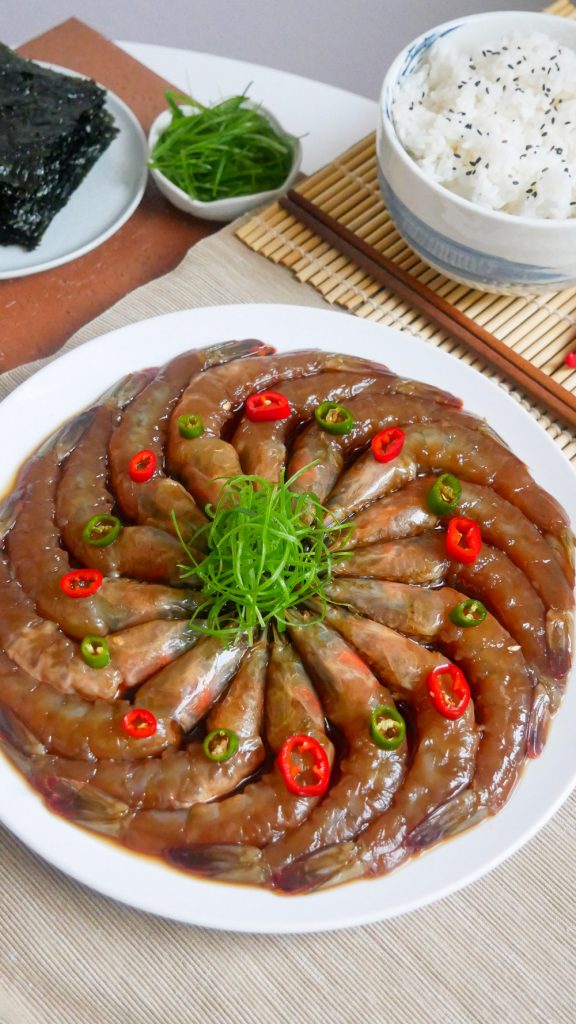
Frequently Asked Questions
How does raw shrimp compare to cooked shrimp?
Raw shrimp is mildly sweet and slightly briny with a soft yet moderately firm, flesh-like texture. Cooked shrimp on the other hand is not briny at all however, the natural sweetness is amplified through the cooking process. In terms of texture, it’s distinctively firmer than raw shrimp.
Is it safe to eat raw shrimp?
When raw shrimp is prepared properly from a reliable source, it is generally safe to consume. Be sure to use frozen shrimp for this recipe unless you have a reliable source for fresh shrimp. The freezing process will kill off any parasites. Keep in mind that there are always risks in consuming raw seafood.
Can you use other seafood for this recipe?
Yes absolutely! This marinade is incredibly versatile and can be used with scallops, salmon, tuna, yellowtail, abalone, and crab.
How long should you marinate the raw shrimp?
For best results, I recommend marinating the raw shrimp for at least 24 hours or up to 48 hours. You can consume it earlier however it won’t be as cured or flavorful. Keep in mind that the longer it marinates, the more flavorful and saltier the shrimp will be.
How can you store marinated raw shrimp in the fridge?
This dish should be stored in a glass container with an air-tight lid so it stays as fresh as possible. It’s best consumed within two days.
Looking for more easy and delicious shrimp recipes?
- Shrimp Summer Rolls – these shrimp summer rolls are made of fresh ingredients that combine a medley of sweet, spicy, umami, and tangy flavors into one mouth-watering dish. It mostly consists of vegetables which makes them a great snack, appetizer, or light meal
- Honey Walnut Shrimp – this dish is a classic Cantonese staple and one of my favorite shrimp recipes to make. It’s served with crispy shrimp, honey walnuts, and fresh broccoli and tossed in a delectable sweet mayo sauce.
- Salt and Pepper Shrimp – salt and pepper shrimp is a combination of juicy succulent shrimp on the inside and a crunchy airy outer shell. The salt and pepper combined with the aromatics is the perfect balance between savory and spicy.
- Chinese Scrambled Eggs with Shrimp – the combination of the juicy succulent shrimp and silky velvety scrambled eggs is incredibly delicious. 10 minutes is all you need to prepare this dish!
- Thai Shrimp Green Curry with Vegetables – this Thai green curry will bring you right to the streets of Thailand! It’s fragrant, spicy, and easily customizable with your favorite proteins or vegetables.
- Crispy Shrimp Toast (Menbosha) – treat yourself to this extra indulgent crispy shrimp toast. With just a few simple everyday ingredients, you can create the crunchiest, most delicious snack at home!
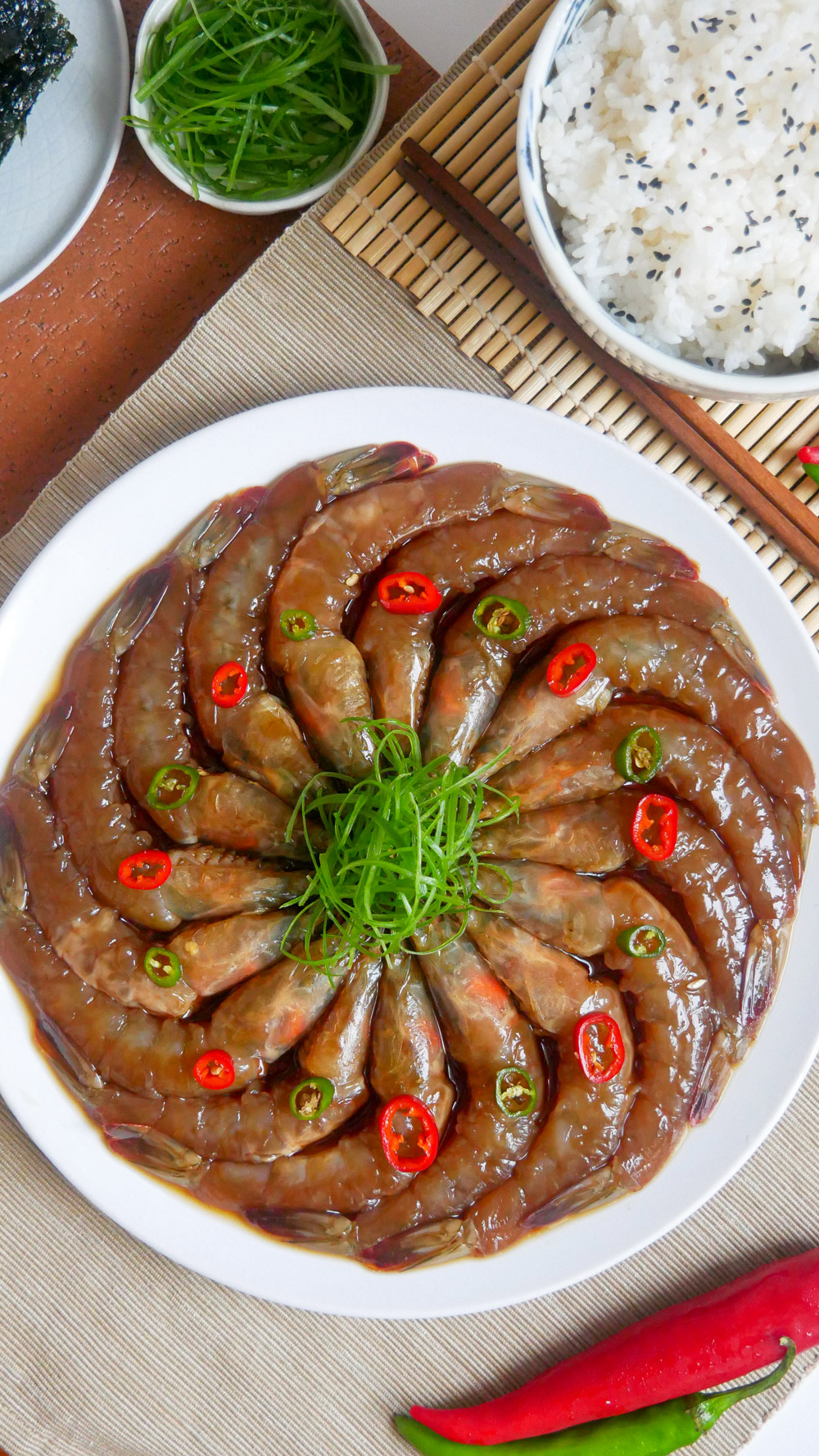
Korean Marinated Raw Shrimp Recipe – 새우장 (Saewoo Jang)
Ingredients
- 1 lb frozen head on shrimp defrosted/thawed
- 1/2 cup soju
- 1/4 onion thinly sliced
- 1 cheongyang pepper chopped, substitute with serrano, jalapeno, or habanero
- 1 red chili pepper chopped, substitute with serrano, jalapeno, or habanero
- 1/3 lemon thinly sliced
Marinade
- 1 cup soy sauce
- 1 1/4 cups water
- 1/4 cup soju substitute with mirin or sake
- 1/4 cup mirin substitute with soju or sake
- 2 tbsp plum extract syrup called maeshil cheong (매실청), substitute with sugar
- 1 1/2 tbsp sugar
- 2 dried kelp 2×2 inch pieces
- 1/4 onion thinly sliced
- 1/4 apple thinly sliced
- 1 scallions cut into 2 inch pieces
- 5 garlic cloves
- 1 1/4 inch slice ginger
- 1 cheongyang pepper chopped, substitute with serrano, jalapeno, or habanero
- 2 dried pepper
- 1/4 tsp whole black peppercorns about 10 peppercorns
Instructions
- Start by preparing the marinade. In a pot, combine soy sauce, water, soju, mirin, plum syrup, sugar, dried kelp, onion, apple, scallions, garlic, ginger, cheongyang pepper, dried pepper, and peppercorns. Bring to a boil over medium heat then reduce to a simmer. Simmer for 10 minutes then strain. Transfer to the fridge to cool completely.
- Next, prep the shrimp. If shrimp is still frozen, soak it in a bowl with 4 cups of water and 1 tablespoon of salt for 30 minutes or until defrosted. If your shrimp is already defrosted and thawed, skip this step.
- Using a pair of sheers, cut the pointy areas of the head, whiskers, and legs. Carefully remove the shell from the body of the shrimp. The tail can be left on or taken off – it's your preference!
- Next, devein the shrimp with the toothpick. Repeat until all shrimp is cleaned. Transfer the shrimp to a shallow plate. Add 1/2 cup soju and soak for 10 to 15 minutes. Rinse under cold water then strain well.
- Transfer the shrimp to a clean glass container. Top with onions, cheongyang pepper, red pepper, and lemon slices. Pour the chilled marinade on top of the shrimp. Cover with an airtight lid then place in the fridge for at least 24 hours or up to 48 hours.
- Serve with a bowl of rice and enjoy!
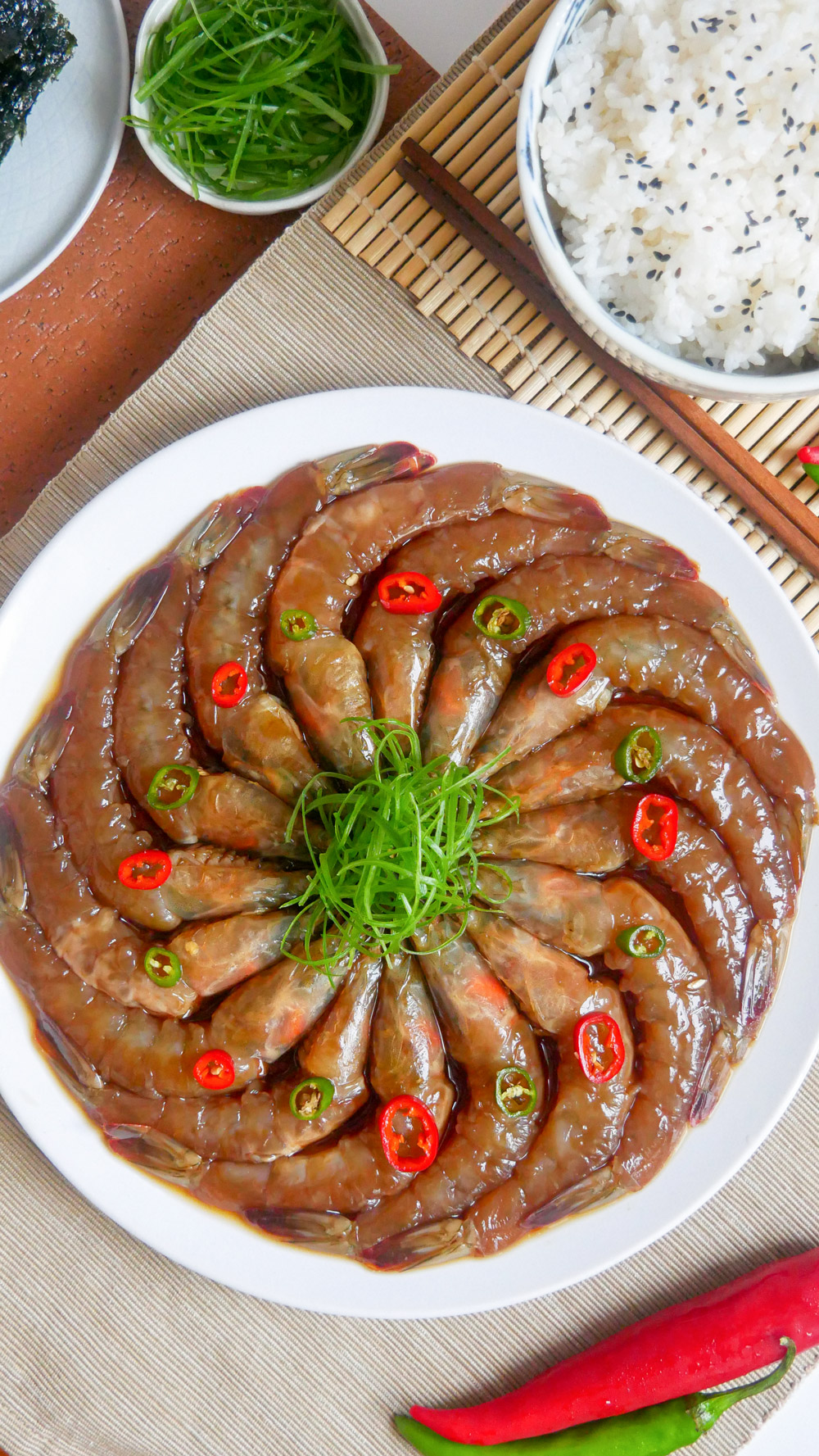
Hi,
I’m Muslim and can’t drink soju, mirin, or sake. Is there any alternatives for that step of the recipe?
Hi Samia, You can skip it! 🙂